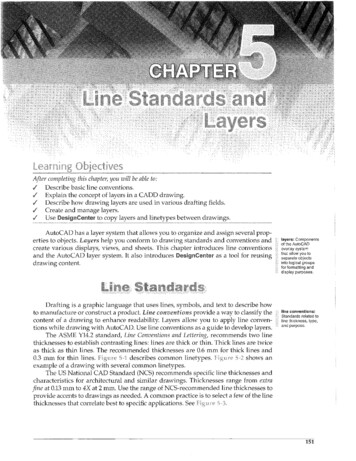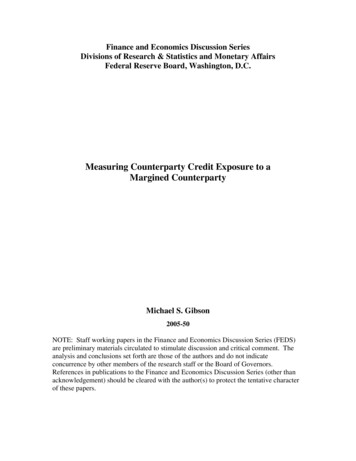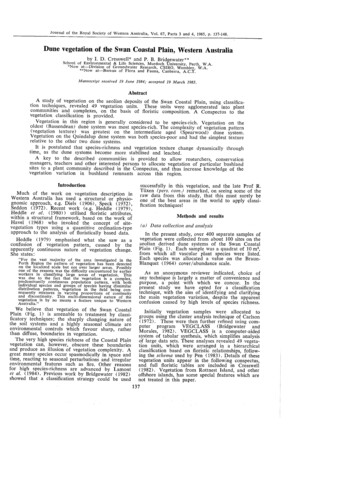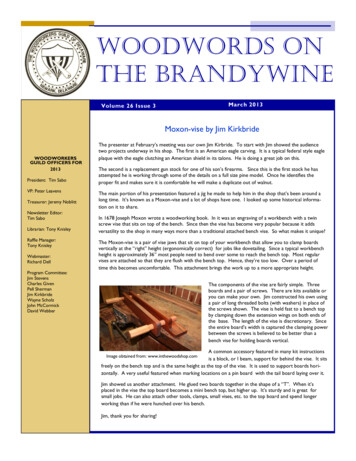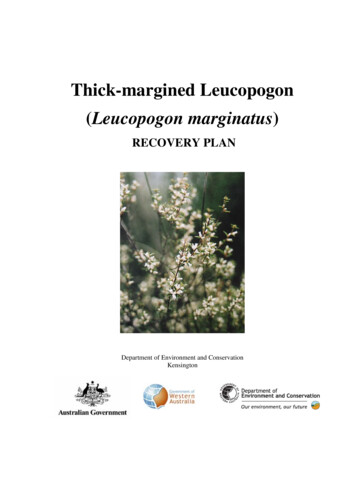
Transcription
Thick-margined Leucopogon(Leucopogon marginatus)RECOVERY PLANDepartment of Environment and ConservationKensington
Recovery Plan for Leucopogon marginatusFOREWORDInterim Recovery Plans (IRPs) are developed within the framework laid down in Department of Conservation and LandManagement (CALM) Policy Statements Nos. 44 and 50. Note: the Department of CALM formally became theDepartment of Environment and Conservation (DEC) in July 2006. DEC will continue to adhere to these Policy Statementsuntil they are revised and reissued.IRPs outline the recovery actions that are required to urgently address those threatening processes most affecting theongoing survival of threatened taxa or ecological communities, and begin the recovery process.DEC is committed to ensuring that Threatened taxa are conserved through the preparation and implementation of RecoveryPlans (RPs) or IRPs, and by ensuring that conservation action commences as soon as possible.This IRP will operate from May 2008 to April 2013 but will remain in force until withdrawn or replaced. It is intended that,if the taxon is still ranked Endangered (EN) this IRP will be reviewed after five years and the need for further recoveryactions assessed.This IRP was given Regional approval on 10 April 2008 and approved by the Director of Nature Conservation on 30 May2008 The allocation of staff time and provision of funds identified in this IRP is dependent on budgetary and otherconstraints affecting DEC, as well as the need to address other priorities.Information in this IRP was accurate as at May 2008.This IRP was prepared with financial support from the Australian Government to be adopted as a National Recovery Planunder the provisions of the Commonwealth Environment Protection and Biodiversity Conservation Act 1999 (EPBC Act).IRP PREPARATIONThis Interim Recovery Plan was prepared by Alanna Chant1 and Gillian Stack2.12Conservation Officer, DEC’s Geraldton District, PO Box 72, Geraldton, WA 6531.Project Officer, Species and Communities Branch, DEC, Locked Bag 104, Bentley Delivery Centre, 6983.ACKNOWLEDGMENTSThe following people have provided assistance and advice in the preparation of this IRP:Jenny BorgerGina BrounAndrew BrownAlex ChapmanAndrew CrawfordAnthony DesmondVal EnglishMike HislopMichael JonesMark OoiConsultant Botanist, Moora District, DECFormer Conservation Officer, Moora District, DECThreatened Flora Coordinator, Species and Communities Branch, DECResearch Scientist, WA Herbarium, DECTechnical Officer, Threatened Flora Seed Centre, DECProgram Leader Nature Conservation, Midwest Region, DECPrincipal Ecologist, Species and Communities Branch, DECConsultant, WA Herbarium, DECHorticulturalist, Botanic Gardens and Parks AuthorityResearch Associate, Department of Environment and Conservation NSWThanks also to the staff of the W.A. Herbarium for providing access to Herbarium databases and specimen information.Thanks also to DEC’s Species and Communities Branch and the private land holders who provided information on alteredcontact details, new land divisions and assistance in locating new and old populations in the field.Cover photograph by Alanna ChantCITATIONThis Recovery Plan should be cited as:Department of Environment and Conservation (2009) Thick-margined Leucopogon (Leucopogon marginatus) RecoveryPlan, Department of Environment and Conservation, Western Australia.2
Recovery Plan for Leucopogon marginatusSUMMARYScientific Name:Family:DEC Region:Shires:NRM Region:Leucopogon marginatusEpacridaceaeMidwestMullewa, Greenough, ThreeSpringsNorthern AgriculturalCommon Name:Flowering Period:DEC District:Recovery Team:Thick Margined LeucopogonJuly - AugustGeraldton, MooraGeraldton and Moora District ThreatenedFlora Recovery TeamsIllustrations and/or further information: Atkins, K. (2008) Declared Rare and Priority Flora List for WesternAustralia. Department of Environment and Conservation, Western Australia. Blackall, W. E. and Grieve, B. J. (1981) Howto Know Western Australian Wildflowers IIIB, 2nd ed: p 345. University of Western Australia Press, Nedlands; Brown, A.,Thomson-Dans, C. and Marchant, N. (Eds) (1998) Western Australia’s Threatened Flora, Department of Conservation andLand Management, Western Australia; Brown, E. (1997) Unpublished illustration and description; DEC (2008) WesternAustralian Herbarium FloraBase 2 – Information on the Western Australian Flora. Department of Environment andConservation, Western Australia. http://www.calm.wa.gov.au/science/; Elliot, W. R. and Jones D. L. (1993) Encyclopaediaof Australian Plants Suitable for Cultivation 6: pp. 167. Lothian Publishing Company, Melbourne; Fitzgerald, W. V.(1904) Leucopogon marginatus, Journal of the Western Australian Natural History Society, 2(1):27.Current status: Leucopogon marginatus was declared as Rare Flora under the Wildlife Conservation Act 1950 in October1996 and was ranked as Endangered (EN) under World Conservation Union (IUCN 1994) Red List criterion D in 2000 asless than 250 individuals were known at that time. The main threats are inappropriate fire regimes, vegetation clearing,rabbits, weeds, road and firebreak maintenance and gravel removal. The species is listed as Endangered under theCommonwealth Environment Protection and Biodiversity Conservation Act 1999 (EPBC Act).Description: Leucopogon marginatus is a dwarf shrub 40-60 cm tall with smooth, young growth and erect, smooth stems.This species is distinguished from others by the crisp, undulate and membranous margins of the leaf, and the white beardedflowers that appear in the upper leaf axils in groups of one to three per stalk. The lance-like pointed leaves are dark green,overlapping and embrace the stem (Brown et al. 1998).Habitat requirements: Leucopogon marginatus is currently known over a range of 100 km from east of Geraldton, southto the Arrino Sandplain. The species is found on white, pale yellow or grey-brown sand over laterite, in open scrub anddense low heath with Allocasuarina humilis, Jacksonia nutans, Daviesia daphnoides, Hakea prostrata, H. trifurcata,Acacia blakelyi, Hibbertia hypericoides, Eremaea beaufortioides, Banksia scabrella, B. prionotes, Grevilleacandelabroides and Melaleuca sp.Habitat critical to the survival of the species and important populations: Given that Leucopogon marginatus is rankedas EN, it is considered that all known habitat for wild populations is critical to the survival of the species, and that all wildpopulations are important populations. Habitat critical to the survival of L. marginatus includes the area of occupancy ofpopulations; areas of similar habitat surrounding and linking populations (these providing potential habitat for populationexpansion and for pollinators); additional occurrences of similar habitat that may contain undiscovered populations of thespecies or be suitable for future translocations and the local catchment for the surface and/or groundwater that maintains thehabitat of the species.Benefits to other species or ecological communities: Recovery actions implemented to improve the quality or security ofhabitat of Leucopogon marginatus will also protect other Declared Rare Flora (DRF) and Priority Flora. Associated DRFare Conostylis micrantha and Conostylis dielsii subsp. teres. Priority flora include Grevillea hirtella (P3), Grevilleaerinacea (P3), Baeckea sp. Walkaway (P3) and Banksia scabrella (P4).International obligations: This plan is fully consistent with the aims and recommendations of the Convention onBiological Diversity, ratified by Australia in June 1993, and will assist in implementing Australia’s responsibilities underthat Convention. Leucopogon marginatus is not listed under any specific international treaty and this IRP does not affectAustralia’s obligations under any other international agreements.Indigenous consultation: The Aboriginal Sites Register maintained by the Department of Indigenous Affairs does not listany significant sites in the vicinity of known populations of Leucopogon marginatus, however, the Yamatji Land and SeaCouncil, was consulted in order to identify possible indigenous interest in the habitat or recovery of Leucopogonmarginatus and a representative was invited to become a member of the Geraldton District Threatened Flora RecoveryTeam.Social and economic impact: As Populations 14 to 20 and 23 to 26 occur on private property the protection of the speciesin these areas has the potential to affect future development. Recovery actions refer to continued liaison between3
Recovery Plan for Leucopogon marginatusstakeholders.Evaluation of the plan’s performance: The Department of Environment and Conservation, in conjunction with theGeraldton and Moora Districts Threatened Flora Recovery Teams, will evaluate the performance of this IRP. In addition toannual reporting on progress and evaluation against the criteria for success and failure, the plan will be reviewed followingfive years of implementation.Completed Recovery Actions1.2.3.4.5.6.Relevant land managers have been made aware of the location and threatened status of the species.Declared Rare Flora (DRF) markers are in place for road and most firebreak populations.Rabbit baiting was conducted at a Nature Reserve population in 1999. Follow-up baiting was undertaken in 2000.New populations have been found as a result of surveys undertaken by staff from DEC’s Geraldton District and theWA Herbarium.A botanist contracted to DEC’s Moora District in 2005 found six new populations on private property whileundertaking a survey of remnant sandplain vegetation.Staff from DEC’s Geraldton District have implemented a pre-suppression fire management strategy in a NatureReserve that contains seven populations of the species.Ongoing and future recovery actions1. Staff from DEC’s Geraldton District regularly monitor populations of the species and maintain close liaison withrelevant land managers.2. The Geraldton District Threatened Flora Recovery Team (GDTFRT) and Moora District Threatened Flora RecoveryTeam (MDTFRT) are overseeing the implementation of this IRP and will include information on progress in theirannual reports to DEC’s Corporate Executive and funding bodies.IRP objective: The objective of this IRP is to abate identified threats and maintain or enhance viable in situ populations toensure the long-term preservation of the species in the wild.Criteria for success: The number of populations has increased or the number of individuals within populations haveincreased by ten percent or more over the five year term of the plan.Criteria for failure: The number of populations has decreased or the number of individuals within populations havedecreased by ten percent or more over the five year term of the plan.Recovery actions1.2.3.4.5.6.7.Coordinate recovery actionsMap habitat critical to survival of Leucopogon marginatusLiaise with relevant land managers and Indigenous groupsMonitor populationsImplement rabbit controlImplement weed controlObtain information on post fire regeneration8.9.10.11.12.13.Develop and implement a fire management strategyConduct further surveysCollect seedPromote awarenessInstall markersReview this plan and assess the need for further recoveryactions4
Recovery Plan for Leucopogon marginatus1.BACKGROUNDHistoryThe type specimen of Leucopogon marginatus was collected from the Arrino Sandplains by W.V. Fitzgerald inSeptember 1903. Further collections of the species were made in July 1985 and in August 1986. The specieswas then not seen again until July 2000, when it was relocated near the 1986 collection following surveys byGeraldton District staff. During the same month staff from the WA Herbarium collected the species in a nearbyNature Reserve. Further surveys by District staff in 2001 and 2003 resulted in four more populations beingfound in the same nature reserve and, in 2003, the Geraldton Regional Herbarium Group collected the speciesfrom two sites on a Water Reserve. Surveys conducted by District staff during 2004 determined that a largepopulation of the species occurred at this site. During July 2005, as part of a Commonwealth Governmentfunded project to implement conservation actions for Threatened Flora in the Geraldton to Shark Bay SandplainBiodiversity Hotspot, a botanist contracted to DEC discovered six new populations on private property. Afurther two new populations, one on private property and one in a gravel reserve, were discovered later in2005/06.Most known populations have shown declines, although population 14 shows a substantial increase (from 17plants in 2005 to 360 plants in 2008). A total of 861 individuals in 26 populations are now known over a rangeof 100 km.DescriptionLeucopogon marginatus is a dwarf shrub 40-60 cm tall with smooth young growth and stems. The erect lancelike leaves with crisp membranous margins and sharply pointed tip are dark green, overlap and embrace thestem. The leaves, which are 4-6 mm long with a very short petiole, are distinguished by their concave shape andthe longitudinal ridges in their lower portion. The white flowers appear in the upper leaf axils in groups of oneto three. At the base of each flower is a bracteole, one third as long as each of the five sepals. This bracteole alsohas a membranous margin. The corolla forms a tube slightly longer than the calyx. It has five free lobes whichare bearded inside and have pointed hairless tips. The oblong anthers are attached near the top of the corollatube and lack sterile tips. The style is slightly longer than the corolla tube (Brown 1998 unpl.).Leucopogon marginatus populations surveyed during 2005 were found to contain individuals that areconsiderably larger (up to 170cm in height) than those recorded in published descriptions.Leucopogon marginatus is allied to L. obtectus and L. crassiflorus differing from the former in its foliage shapeand from the latter in foliage and inflorescence shape (Fitzgerald 1904). L. marginatus is not considered a trueLeucopogon as it lacks sterile anther tips, has an axillary rather than a terminal inflorescence, has a long corollatube relative to the calyx length and has a longer style. It is likely that it will be transferred to a new genus(Mike Hislop pers. comm.).Leucopogon marginatus has previously been confused with L. sulcatus ms which grows in the Bruce Rock,Merredin, Southern Cross and Forrestania areas. In the area where L. marginatus is now known to occur it couldbe confused with L. hamulosus and L. sp. Arrino (Mike Hislop pers. comm.).Distribution and habitatLeucopogon marginatus is currently known over a range of 100 km from east of Geraldton, south to the ArrinoSandplain. The species is found on white, pale yellow or grey-brown sand over laterite, in open scrub and denselow heath with Allocasuarina humilis, Jacksonia nutans, Daviesia daphnoides, Hakea prostrata, H. trifurcata,Acacia blakelyi, Hibbertia hypericoides, Eremaea beaufortioides, Banksia scabrella, B. prionotes, Grevilleacandelabroides and Melaleuca sp.5
Recovery Plan for Leucopogon marginatusSummary of population land vesting, purpose and managementPop. No. & Location1.2.3.4.Erangy SpringsBurma RoadSandsprings RoadBurma n5.Burma RoadGeraldtonGreenough6.Burma RoadGeraldtonGreenough7.E of GeraldtonGeraldtonGreenough8.Burma RoadGeraldtonGreenough9.Burma RoadGeraldtonGreenough10. Burma RoadGeraldtonGreenough11. Burma RoadGeraldtonGreenough12. Burma RoadGeraldtonGreenough13. W of raMooraMooraMooraMooraMooraMooraMooraThree SpringsThree SpringsThree SpringsThree SpringsThree SpringsThree SpringsThree SpringsThree SpringsNE of ArrinoNE of ArrinoNE of ArrinoNE of ArrinoNE of ArrinoNE of ArrinoN of ArrinoE of GreenoughUnknownUnvested ReserveUnknownConservation Commissionof Western AustraliaConservation Commissionof Western AustraliaConservation Commissionof Western AustraliaMain Roads WesternAustraliaConservation Commissionof Western AustraliaConservation Commissionof Western AustraliaConservation Commissionof Western AustraliaConservation Commissionof Western AustraliaConservation Commissionof Western AustraliaMain Roads eeholdFreeholdFreeholdMain Roads WesternAustraliaWater AuthorityFreeholdFreeholdFreeholdUnknownRoad ReserveUnknownConservation of Floraand FaunaConservation of Floraand FaunaConservation of Floraand FaunaWaterGreenoughGeraldton22. GreenoughGeraldton Greenough23. Greenough24. Allanooka Springs Geraldton GreenoughGeraldton Greenough25. SW of BurmaRoadGeraldton Greenough26. N of SandspringsRoadAll populations are considered important populations.FreeholdConservation of Floraand FaunaConservation of Floraand FaunaConservation of Floraand FaunaConservation of Floraand FaunaConservation of Floraand FaunaRoad ReserveManagerShire of GreenoughDECDECDECMain Roads WesternAustraliaDECDECDECDECDECWaterPrivate PropertyPrivate PropertyPrivate PropertyMain Roads WesternAustraliaLand holderLand holderLand holderLand holderLand holderLand holderLand holderMain Roads WesternAustraliaWater AuthorityLand holderLand holderLand holderPrivate PropertyLand holderPrivate PropertyPrivate PropertyPrivate PropertyPrivate PropertyPrivate PropertyPrivate PropertyPrivate PropertyGravel ReserveBiology and ecologyThe genus Leucopogon is a member of the Ericaceae (previously Epacridaceae) family and containsapproximately 160 species, mostly Australian but also some found in Malaysia, New Caledonia, New Zealandand the Pacific Islands. They occur in a variety of habitats from sub-alpine areas to coastal heaths. The greatestrepresentation is in south-western WA, where there are approximately 100 species (Elliot and Jones 1993).Many members of the Epacridaceae family are killed by fire and are re-seeders (Keighery 1995). Populations ofLeucopogon marginatus that were burnt during a wildfire in January 2005 contained no resprouting plants inSeptember the same year. In 2000 L. marginatus was recorded from an area that had been burnt in 1996,suggesting that it regenerates successfully from seed after fire and that mature flowering individuals are presentwithin four years. A study investigating dormancy breaking cues for three Leucopogon species indicates thatfresh seeds studied are dormant at release (Ooi et al. unpublished paper). They have underdeveloped embryosand primary dormancy was overcome by seasonal temperature changes. Fire cues did not break primarydormancy but smoke could enhance germination once this dormancy was overcome (Ooi et al. unpublishedpaper).The pollinators of Leucopogon marginatus are as yet unknown. Leucopogon species have unspecialized flowersand are mainly pollinated by bees, but are also visited by a range of other insects including flies, wasps,6
Recovery Plan for Leucopogon marginatusbutterflies and moths. The fruits are fleshy drupes that are mostly animal dispersed, usually after ingestion bybirds (Keighery 1995).Most genera in the family contain species that are susceptible to Phytophthora cinnamomi (dieback). However,P. cinnamomi is considered a relatively low risk to Leucopogon marginatus (Keighery 1988) due to its habitatconsisting of well-drained soils and its location within the 300–400 mm rainfall zone.ThreatsThe main threats are inappropriate fire regimes, vegetation clearing, rabbits, weeds, road and firebreakmaintenance and gravel removal. Inappropriate fire regimes during the reproductive phase of Leucopogon marginatus may result in low/nilseedling recruitment. High fire frequency may also lead to a degradation of the habitat of L marginatus andthis is covered under action 8.Vegetation clearing threatens several populations of Leucopogon marginatus on private property. Anapplication to clear portions of the remnant has been submitted to the Department of Environment howeverthis is unlikely to affect the population. Liaison with the property owners will be ongoing to protect theplants. This is covered under action 3.Grazing by livestock threatens several populations on private property and is covered under action 3.Edge effects affect populations that are restricted to narrow road reserves. These include increased windspeed, fertiliser and herbicide spray drift and runoff, modified hydrology and altered disturbance regimes.Liaison with relevant parties to prevent this are covered under action 3.Rabbits (Oryctolagus cuniculus) are impacting populations on a Nature Reserve. Rabbits do not appear tograze adult plants but the habitat is subject to digging in some areas.Weed infestation has increased along the boundaries of a Nature Reserve where several populations ofLeucopogon marginatus occur.Road, firebreak, powerline and fenceline maintenance threatens several populations.Gravel extraction is a threat to Population 21 and is covered by action 3.Summary of population information and threatsPop. No. & LocationDEC DistrictLand StatusYear/No.plantsConditionThreats1. Erangy SpringsGeraldtonUnknownUnknownRoad maintenance, weeds2. Burma RoadGeraldtonShire Road ReserveModerate/PoorRoadworks, inappropriate fireregimes, edge effects3. Sandsprings RoadGeraldtonUnknown4. Burma RoadGeraldtonNature Reserve5. Burma RoadGeraldtonNature Reserve6. Burma RoadGeraldtonNature Reserve7. E of GeraldtonGeraldtonWater Reserve1985 02000 02004 02008 02000 12001 12002 02004 02008 01986 ?2008 020002004 22005 ?2004 02000 50 2004 50 2005 02008 02000 392005 02008 02003 142004 1452005 1452008 2UnknownHealthyRabbits, inappropriate fireregimesBurntInappropriate fire regimes,rabbitsHealthy (burnt)Firebreak maintenance,rabbits, inappropriate fireregimesTrack maintenance,inappropriate fire regimes,powerline maintenanceHealthy7
Recovery Plan for Leucopogon marginatusPop. No. & LocationDEC DistrictLand StatusYear/No.plantsConditionThreats8. Burma RoadGeraldtonNature ReserveHealthyInappropriate fire regimes9. Burma RoadGeraldtonNature ReserveHealthy (burnt)Inappropriate fire regimes10. Burma RoadGeraldtonNature ReserveHealthy (burnt)Inappropriate fire regimes11. Burma RoadGeraldtonNature ReserveHealthyInappropriate fire regimes12. Burma RoadGeraldtonNature ReserveHealthyInappropriate fire regimes13. W of EraduGeraldtonMain Roads RoadReserveModerate14. NE of ArrinoMooraPrivate Property2003 102005 102008 02003 60 2005 ?2008 02003 92005 02008 02003 352005 352008 352004 582008 02003 12005 12008 12005 172008 36015. NE of ArrinoMooraPrivate Property2005 212008 21Healthy16. NE of ArrinoMooraPrivate PropertyHealthy17. NE of ArrinoMooraPrivate Property2005 4002008 552005 552008 6518. NE of ArrinoMooraPrivate PropertyHealthy19. NE of ArrinoMooraPrivate Property20. N of ArrinoMooraPrivate Property21. E of ArrinoMooraGravel Reserve2005 42008 52005 1002008 42005 42008 42006 300 2008 3002008 12008 22008 02008 02008 6Road maintenance,inappropriate fire regimes,edge effectsVegetation clearing,inappropriate fire regimes,grazingVegetation clearing, livestockgrazing, inappropriate fireregimesInappropriate fire regimes,grazing, vegetation clearingVegetation clearing, grazing,weeds, inappropriate fireregimesWeeds, inappropriate fireregimesGrazing, vegetation clearing,inappropriate fire regimesWeeds, edge effect,inappropriate fire regimesGravel removal, inappropriatefire nWater Reserve22. GreenoughGeraldtonPrivate Property23. GreenoughPrivate Property24. Allanooka Springs GeraldtonPrivate Property25. SW of Burma Road GeraldtonGeraldtonPrivate Property26. N of SandspringsRoadAll Populations are considered important HealthyModerateModerateUnknownUnknownUnknownGuide for decision-makersThe above table provides details of current and possible future threats. Proposed actions in the immediatevicinity of populations or within the defined habitat critical to the survival of Leucopogon marginatus requireassessment for the potential for a significant level of impact.Habitat critical to the survival of Leucopogon marginatus and important populationsGiven that Leucopogon marginatus is ranked as Endangered, it is considered that all known habitat for wildpopulations is critical to the survival of the species, and that all wild populations are important populations.Habitat critical to the survival of L. marginatus includes the area of occupancy of populations; areas of similarhabitat surrounding and linking populations (these providing potential habitat for population expansion and forpollinators); additional occurrences of similar habitat that may contain undiscovered populations of the speciesor be suitable for future translocations and the local catchment for the surface and/or groundwater that maintainsthe habitat of the species.8
Recovery Plan for Leucopogon marginatusBenefits to other species or ecological communitiesRecovery actions implemented to improve the quality or security of habitat of Leucopogon marginatus will alsoprotect other Declared Rare Flora (DRF) and Priority Flora. Associated DRF are Conostylis micrantha andConostylis dielsii subsp. teres. Priority flora include Grevillea hirtella (P3), Grevillea erinacea (P3), Baeckeasp. Walkaway (P3) and Banksia scabrella (P4).Conservation-listed flora species occurring in habitat of Leucopogon marginatusSpecies nameConservation Status (Western Australia)Conostylis micranthaDRF, Critically EndangeredConostylis dielsii subsp. teresDRF, Critically EndangeredGrevillea hirtellaPriority 3Grevillea erinaceaPriority 3Baeckea sp. WalkawayPriority 3Banksia scabrellaPriority 4For a description of the priority categories see Atkins (2006)Conservation Status (EPBC Act)EndangeredEndangeredInternational obligationsThis plan is fully consistent with the aims and recommendations of the Convention on Biological Diversity,ratified by Australia in June 1993, and will assist in implementing Australia’s responsibilities under thatConvention. Leucopogon marginatus is not listed under any specific international treaty and this IRP does notaffect Australia’s obligations under any other international agreements.Indigenous consultationThe Aboriginal Sites Register maintained by the Department of Indigenous Affairs does not list any significantsites in the vicinity of known populations of Leucopogon marginatus, however, the Yamatji Land and SeaCouncil, was consulted in order to identify possible indigenous interest in the habitat or recovery of Leucopogonmarginatus and a representative was invited to become a member of the Geraldton District Threatened FloraRecovery Team. Where no role is identified for the indigenous community associated with this species in thedevelopment of the recovery plan, opportunities may exist through cultural interpretation and awareness of thespecies. Indigenous involvement in the implementation of recovery actions will be encouraged.Continued liaison between DEC and the indigenous community will identify areas in which collaboration willassist implementation of recovery actions.Social and economic impactsAs Populations 14 to 20 occur on private property the protection of the species in these areas has the potential toaffect future development. Recovery actions refer to continued liaison between stakeholders.Affected InterestsStakeholders potentially affected by the implementation of this plan include owners of private property, MainRoads Western Australia and Shires.Evaluation of the plan’s performanceThe Department of Environment and Conservation, in conjunction with the Geraldton and Moora DistrictsThreatened Flora Recovery Teams, will evaluate the performance of this IRP. In addition to annual reporting onprogress and evaluation against the criteria for success and failure, the plan will be reviewed following fiveyears of implementation.9
Recovery Plan for Leucopogon marginatus2.RECOVERY OBJECTIVE AND CRITERIAObjectivesThe objective of this IRP is to abate identified threats and maintain or enhance viable in situ populations toensure the long-term preservation of the species in the wild.Criteria for success: The number of populations has increased or the number of individuals within populationshave increased by ten percent or more over the five year term of the plan.Criteria for failure: The number of populations has decreased or the number of individuals within populationshave decreased by ten percent or more over the five year term of the plan.3.RECOVERY ACTIONSCompleted recovery actionsThe Water Corporation, Shire of Greenough, Western Power and owners of private property where populationsof Leucopogon marginatus have been found have been notified of the plant’s presence. The notification detailsthe Declared Rare status of L. marginatus and associated legal obligations. Onsite liaison has also occurredbetween representatives of DEC and the Water Corporation and an environmental consultant to Western Powerregarding appropriate management of the populations in a Water Reserve.Declared Rare Flora (DRF) markers have been installed at all road verge populations and some populations thatoccur along firebreaks. These markers alert road and rail maintenance workers to the presence of eachpopulation, and enable them to take appropriate care.Geraldton District staff conducted rabbit baiting within the Nature Reserve, which contains several populationsof Leucopogon marginatus, in 1999 in an attempt to reduce rabbit numbers and their impact on the habitat atthose sites. Further baiting was undertaken in 2000. Between 2000 and 2004 rabbit activity was monitored andrecorded at a low level, however during 2005 rabbit numbers were recorded as increasing.Staff from DEC’s Geraldton District have undertaken surveys of suitable habitat and discovered newpopulations of this species.Staff from DEC’s WA Herbarium have searched for Leucopogon marginatus and made collections of thespecies at three locations in a Nature Reserve.A botanist contracted
Melaleuca : sp. Habitat critical to the survival of the species and important populations: Given that : . Recovery actions implemented to improve the quality or security of habitat of : Leucopogon marginatus : will also protect other Declared Rare Flora (DRF) and Priority Flora. Associated DRF are : Conostylis micrantha :
